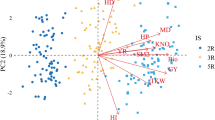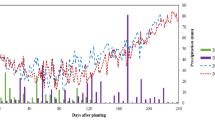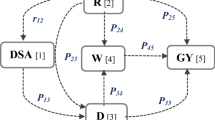Abstract
The response of three durum wheat cultivars (C: Chen’s, V: Vitron, W: Waha) to irrigation was studied during 4 years in semi-arid Algeria (Chlef). The four treatments were NI (unirrigated), EI (early irrigation, up to heading), LI (late irrigation, from heading) and FI (full irrigation, over the entire season). FI increased rainfed grain yield (1,300 kg ha−1) by 270%, EI by 107%, and LI by 67%. The variety × irrigation interaction was significant each year. Under irrigation, cv. Vitron was generally the most productive cultivar while in rainfed conditions cv. Waha always resulted in the highest grain yield. Grain yield increased exponentially with seasonal evapotranspiration (r 2 = 0.741) and harvest index (r 2 = 0.873). Water use efficiency for grain ranged from 4.6–5.3 kg ha−1 mm−1 (NI) to 9.6–10.8 kg ha−1 mm−1 (FI) as a function of cultivar and irrigation, cv. Vitron and cv. Waha (full irrigation) and cv. Waha (rainfed) being the most efficient cultivars. According to the evaporation pan method, the seasonal crop coefficient (K c) values for the three cultivars were 0.64 (V), 0.62 (W) and 0.54 (C). The corresponding peak K c values were 1.0, 0.97 and 0.89, respectively. K c was closely related to leaf area index (LAI) and specific logarithmic relationships were calculated for each cultivar. Irrigation scheduling should be adapted to the type of cultivar in relation to its potential yield and LAI development pattern.











Similar content being viewed by others
References
Al-Khaisi MM, Berrada A, Stack M (1997) Evaluation of irrigation scheduling program and spring wheat yield response in southwestern Colorado. Agric Water Manage 34:137–148
Allen RG, Pereira LS, Raes D, Smith M (1998) Crop evapotranspiration: guidelines for computing crop water requirements. FAO Irrigation and Drainage Paper no 39, Rome
Annicchiarico P, Bellah F, Chiari T (2006) Repeatable genotype × location interaction and its exploitation by conventional and GIS-based cultivar recommendation for durum wheat in Algeria. Eur J Agron 24:70–81
Bandyopadhyay PK, Mallick S (2003) Actual evapotranspiration and crop coefficients of wheat (Triticum astivum) under varying moisture levels of humid tropical command area. Agric Water Manage 59:33–47
Bauder TA, Waskom RM, Davis JG (2006) Irrigation water quality criteria. Crop series Note no 0.506. Colorado State University Cooperative Extension, 4 p
Belaid A (2002) Durum production shortfalls in North Africa: some facts. ICARDA Caravan 16:42–43
Benbelkacem A, Kellou K (2000) Evaluation du progrès génétique chez quelques variétés de blé dur (Triticum turgidum L. var.durum) cultivées en Algérie. Options Mediterr CIHEAM Ser A 40:105–110
Bouzerzour H, Oudina M (1990) The response of durum wheat to early sowing and supplementary irrigation in the eastern high plateaux of Algeria. Rachis 9:22–25
Brisson ML, Casals ML (2005) Leaf dynamics and crop water status throughout the growing cycle of durum wheat crops grown in two contrasted water budget conditions. Agron Sustain Dev 25:151–158
Brisson N, Guevara E, Meira S, Maturano M, Coca G (2001) Response of five wheat cultivars to early drought in the Pampas. Agronomie 21:483–495
Caliandro A, Boari F (1996) Supplementary irrigation in arid and semiarid regions. Medit 7:24–27
Catalano M (1989) Ricerca delle fasi fenologiche piu sensibili allo stress idrico in una cultivar di frumento duro: primi risultati. Irrigazione e Drenaggio 36:145–148
Debaeke P (2003) Irrigation, supplemental. In: Stewart BA, Howell T (eds) Encyclopedia of water science. Marcel Dekker, New York, pp 537–539
Debaeke P (2004) Scenario analysis for cereal management in water-limited conditions by the means of a crop simulation model (STICS). Agronomie 24:315–326
Debaeke P, Puech J, Casals ML (1996) Elaboration du rendement du blé d’hiver en conditions de déficit hydrique:I. Etude en lysimètres. Agronomie 16:3–23
Doorenbos J, Pruitt WO (1977) Crop water requirements. FAO irrigation and drainage paper no 24, Rome
El-Hafid R, Smith DH, Karrou M, Samir K (1998) Root and shoot growth, water use and water use efficiency of spring durum wheat under early-season drought. Agronomie 18:181–195
Fisher RA (1970) The effects of water stress at various stages of development on yield process in wheat. In: Plant response to climatic factors. Proc. Symp., Uppsala, Sweden. 15–20 September 1970, UNESCO, Paris, pp 169–174
Fischer RA, Maurer R (1978) Drought resistance in spring wheat cultivars. 1. Grain yield responses. Aust J Agric Res 29:897–912
Gebeyehou G, Knott DR (1983) Response of durum wheat cultivars to water stress in the field and greenhouse. Can J Plant Sci 63:801–814
Hafsi M, Monneveux P, Merah O, Djekoune A (2001) Discrimination isotopique du carbone et rendement du blé dur dans les hautes plaines sétifiennes, Algérie. Secheresse 12:37–43
Hazmoune T (2000) Erosion des variétés des blés durs cultivés en Algérie. Perspectives. Options Mediterr CIHEAM Ser A 40:291–294
Howell TA, Steiner JL, Schneider AD, Evett SR (1995) Evapotranspiration of irrigated winter wheat: southern high plains. Trans ASAE 38:745–759
Howell TA, Tolk JA, Schneider AD, Evett SR (1998) Evapotranspiration, yield, and water use efficiency of corn hybrids differing in maturity. Agron J 90:3–9
Kang SZ, Gu BJ, Du TS, Zhang JH (2003) Crop coefficient and ratio of transpiration to evapotranspiration of winter wheat and maize in a semi-humid region. Agric Water Manage 59:239–254
Larbi A, Mekliche A, Abed R, Badis M (2000) Effet du déficit hydrique sur la production de deux variétés de blé dur (Triticum turgidum L. var. durum) en région semi-aride. Options Mediterr CIHEAM Ser A 40:295–297
Medeiros GA, Arruda FB, Sakai E (2005) Crop coefficient for irrigated beans derived using three reference evaporation methods. Agric For Meteorol 135:135–143
Mekliche A, Boukecha D, Hanifi-Mekliche L (2003) Etude de la tolérance à la sécheresse de quelques variétés de blé dur (Triticum durum Desf.). I. Effet de l’irrigation de complément sur les caractères phénologiques, morphologiques et physiologiques. Annales INA El-Harrach (Alger) 24:97–110
Merabet BA, Bouthiba A (2004) Effet de l’irrigation de complément sur quelques variétés de blé dur dans une région semi-aride (Plaine du Chelif). Annales INA El Harrach (Alger), 25:89–107
Monneveux P, This D, Belhassen E (1997) Amélioration génétique de la tolérance à la sécheresse. In L’eau dans l’espace rural: production végétale et qualité de l’eau. INRA Editions & AUPELF-UREF, Paris, pp121–142
Musick JT, Porter KB (1990) Wheat. In: Stewart BA, Nielsen DR (eds) Irrigation of agriculture crops. Agron. Monogr. 30. ASA, CSSA, and SSSA. Madison, pp 597–638
Nachit MM, Sorrells ME, Zobel RW, Gauch HG, Fischer RA, Coffman WR (1992) Association of morpho-physiological traits with grain yield and components of genotype-environment interaction in durum wheat. J Genet Breed 46:363–367
Oweis T, Pala M, Ryan J (1998) Stabilizing rainfed wheat yields with supplemental irrigation and nitrogen in a Mediterranean climate. Agron J 90:672–681
Oweis T, Pala M, Ryan J (1999) Management alternatives for improved durum wheat production under supplemental irrigation in Syria. Eur J Agron 11:255–266
Passioura JB (1977) Grain yield, harvest index, and water use of wheat. J Aust Inst Agric Sci 43:117–120
Royo C, Aparicio N, Blanco R, Villegas D (2004) Leaf and green area development of durum wheat genotypes grown under Mediterranean conditions. Eur J Agron 20:419–430
Slafer GA, Araus JL, Royo C, Garcia del Moral LF (2005) Promising eco-physiological traits for genetic improvement of cereal yields in Mediterranean environments. Ann Appl Biol 146:61–70
Stanhill G (2002) Is the class A evaporation pan still the most practical and accurate meteorological method for determining irrigation water requirements? Agric For Meteorol 112:233–236
Sojka RE, Stolzy LH, Fischer RA (1981) Seasonal drought responses of selected wheat cultivars. Agron J 73:838–845
Soltani A, Galeshi S (2002) Importance of rapid canopy closure for wheat production in a temperate sub-humid environment: experimentation and simulation. Field Crops Res 77:17–30
Statistiques Agricoles (2004) Superficies et productions. Ministère de l’Agriculture, Direction des Statistiques Agricoles et des Enquêtes Economiques
Villegas D, Aparicio N, Nachit MM, Araus JL, Royo C (2000) Photosynthetic and developmental traits associated with genotypic differences in durum wheat yield across the Mediterranean basin. Aust J Agric Res 51:891–901
Zhang HP, Oweis TY (1999) Water-yield relations and optimal irrigation scheduling of wheat in the Mediterranean region. Agric Water Manage 38:195–211
Zhang HP, Oweis TY, Garabet S, Pala M (1998) Water-use efficiency and transpiration efficiency of wheat under rain-fed conditions and supplemental irrigation in a Mediterranean-type environment. Plant Soil 201:295–305
Author information
Authors and Affiliations
Corresponding author
Additional information
Communicated by S. Azam-ali.
Rights and permissions
About this article
Cite this article
Bouthiba, A., Debaeke, P. & Hamoudi, S.A. Varietal differences in the response of durum wheat (Triticum turgidum L. var. durum) to irrigation strategies in a semi-arid region of Algeria. Irrig Sci 26, 239–251 (2008). https://doi.org/10.1007/s00271-007-0089-5
Received:
Accepted:
Published:
Issue Date:
DOI: https://doi.org/10.1007/s00271-007-0089-5




